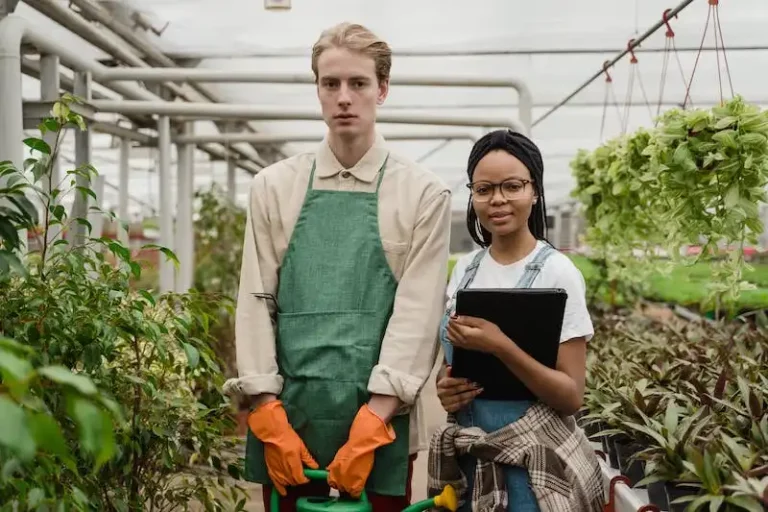Are you tired of trying to figure out what’s best for your indoor plants? Look no further! In this article, I will share with you my no-nonsense universal potting soil recipe that is sure to keep your plants happy and healthy.
Most indoor plants do not thrive in soil-less systems like hydroponics. They require a different type of soil that is based on the natural environment in which they grow. A combination of soil and required nutrients is essential for their growth.
One of the most important tips I can give you is to use a good quality potting soil that is specifically formulated for indoor plants. Brands like Miracle-Gro and FoxFarm are proven winners in this field and can be easily found at your local gardening store.
It is important to note that potting soil is not the same as topsoil or garden soil. The ingredients and conditions are very different, and using the wrong type of soil can lead to unhealthy plants.
My no-nonsense universal potting soil recipe is a perfect alternative to store-bought options. It is a mix of organic materials that replenish the nutrients in the soil and doesn’t require any special directions. Plus, it keeps your plants from becoming waterlogged, which is a common issue with other potting soils.
To make this miracle soil, you will need a combination of premium topsoil, peat moss, and perlite. These ingredients provide the perfect balance of nutrients, drainage, and moisture retention that indoor plants need to thrive.
So, what’s in it for you? By using this no-nonsense potting soil, you can be sure that your indoor plants will look healthy and strong, with vibrant leaves and a well-established root system. Say goodbye to wilting plants and hello to flourishing ones!
Moreover, this recipe has been proven to keep your plants happy and requires minimal effort from your part. Just follow the simple steps outlined in this article, and you’ll be on your way to having the best-looking indoor plants in town.
So, why wait? Try out this no-nonsense universal potting soil recipe today and see the difference it makes for your indoor plants. Happy gardening!
Best Soil for Indoor Plants
When it comes to indoor plants, having the right soil is crucial for their overall health and well-being. The best soil for indoor plants is one that is valid and proven to promote optimal growth and absorption of nutrients. In this article, I will reveal my no-nonsense universal potting soil recipe for indoor plants that has been highly recommended by professionals and enthusiasts alike.
The key to a great indoor potting soil is a well-drained and nutrient-rich medium. One of the best options for indoor plants is a mixture of aged forest bark, horticultural charcoal, and moss. This combination, also called “The Black Gold,” has been proven to provide excellent drainage and aeration, while also retaining moisture. The forest bark and charcoal help to create air pockets in the soil, allowing the roots to breathe and absorb nutrients effectively.
Another important aspect to consider is the pH level of the soil. Most indoor plants prefer a slightly acidic to neutral pH, so it is essential to choose a soil with the right pH balance. A good potting mix should have a pH range of 5.5 to 7.0, which is suitable for a wide variety of plants, including cacti, African violets, and other houseplants.
When selecting a potting soil, keep in mind that it should be lightweight and well-drained. This will prevent waterlogged roots and promote healthier plant growth. Additionally, the soil should be able to hold enough moisture to keep the plants hydrated but should not be too water-retentive to avoid overwatering.
It is important to note that not all potting soils are created equal. Some commercially available potting mixes contain a high content of peat moss, which is not sustainable and can deplete peatland habitats. Inexpensive potting soils may also contain low-quality ingredients and lack essential nutrients.
So, how do you find the best potting soil for your indoor plants? Here are a few tips:
- Consider using a horticultural or African violet soil mix, as they are specifically formulated for these types of plants.
- Look for potting soils that are labeled “well-drained” or “fast-draining” to ensure proper moisture control.
- Check the ingredients list and avoid soils that contain excessive amounts of peat moss or bark fines.
- If you prefer a more sustainable option, choose potting soils that are made from coconut coir, a renewable resource.
- Consider adding perlite or vermiculite to your potting mix to improve drainage and aeration.
In conclusion, the best soil for indoor plants is one that is well-drained, nutrient-rich, and has the right pH balance. It is important to choose a potting mix that is proven to promote optimal plant growth and avoid those that contain low-quality ingredients or harmful components. By following these tips and guidelines, you can provide your indoor plants with the ideal soil they need for healthy and thriving growth.
If you have any further questions about finding the best soil for your indoor plants, check out our FAQ section for more information.
Houseplant compost
When it comes to buying potting soil for your indoor plants, you need to take into account their specific needs. Many houseplants come from forest habitats, where they grow in a rich blend of horticultural materials. To find a potting soil that closely mimics their natural environment, look for one that contains a range of materials such as peat moss, coco coir, or composted forest products.
African violets, for example, prefer a lighter and more well-draining mix, while cactus and succulents thrive in a blend that keeps their roots dry. Horticultural cactus and succulent mixes can be found in stores or you can mix your own by blending equal parts store-bought potting soil and perlite.
Another option is to make your own houseplant compost. This can be a great way to use up organic matter from your garden or kitchen. Composting is a natural process that breaks down organic material into nutrient-rich soil amendments. You can compost things like vegetable scraps, coffee grounds, and eggshells to create a homemade compost that will provide your plants with a wide range of nutrients. However, it’s important to note that composting may attract pests or produce odors, so it’s important to compost properly by following guidelines for maintaining a healthy compost pile.
If you prefer to buy houseplant compost, there are many options available on the market. One premium brand is FoxFarm, which offers a range of potting soils specifically formulated for different types of plants. Their soils are known for their high-quality ingredients and the addition of beneficial microbes and worm castings. Worm castings, also known as vermicompost, are a great organic fertilizer that can improve soil structure and nutrient content.
Overall, the content of your potting soil is crucial for the health and growth of your houseplants. Different plants have different needs, and it’s important to choose a potting soil that suits each plant’s specific requirements. Taking the time to learn about the habitat and nutritional needs of your plants can go a long way in ensuring their success.
When planting, it’s important to know where your plants come from and what type of soil they prefer. For example, African violets prefer a lighter mix, while cactus and succulents thrive in a blend that keeps their roots dry. Other plants, such as bananas or tomatoes, may prefer a heavier soil that contains more organic matter. By figuring out what your plants need, you can mix the perfect blend to support their growth.
Moreover, it’s important to mention that when it comes to houseplants, the potting soil you choose can make a big difference in their overall health and wellness. Many commercial potting soils contain a blend of premium organic materials that are specially formulated to meet the needs of a wide range of indoor plants. These often include ingredients like peat moss, coco coir, or composted forest products. Premium potting soils are also typically enriched with nutrients to support plant growth.
When selecting a pot for your houseplants, you may also want to consider using a raised pot or container with drainage holes. This can help prevent overwatering and provide better airflow to the plant’s roots. Additionally, using a potting mix with added perlite can also enhance drainage and help prevent root rot.
Here are some top picks for houseplant compost:
- FoxFarm Ocean Forest Potting Soil
- Miracle-Gro African Violet Potting Mix
- Espoma Organic Cactus Mix
- Black Gold All Purpose Potting Soil
These potting soils have been widely praised by indoor gardeners for their ability to support healthy plant growth and provide the necessary nutrients for houseplants. They were the winners in a recent survey conducted by a popular digital gardening publication.
Remember, finding the right potting soil is just the beginning. After planting, it’s important to keep your houseplants well-fed by fertilizing regularly. Different plants have different fertilizing needs, so be sure to research what’s best for your specific plants. With the right care and attention, your indoor plants can thrive in the perfect environment you’ve created for them!
Perlite mix
A perlite mix is a great option for indoor plants that require good drainage and aeration. Perlite is a lightweight material that helps to improve soil structure and prevent it from becoming waterlogged. It is commonly used in potting soil mixes to create a well-drained environment for plants.
When creating a perlite mix, it is important to provide proper nutrition for your plants. This can be achieved by using a balanced potting soil or adding organic fertilizers, such as bone meal or potassium sulfate.
One winner when it comes to perlite mix is the Miracle-Gro Perlite Soil Pro. It contains hydrafiber, which helps to retain water while also promoting good drainage. This mix is a trademark product and is a popular choice among indoor gardeners.
To make a perlite mix, combine equal parts perlite, balanced potting soil, and organic fertilizers. Mix these ingredients well in a container. If your fertilizers are in pellet form, break them up before adding them to the mix.
When planting your indoor plants in a perlite mix, it is important to ensure that the container has drainage holes. This will prevent the soil from becoming waterlogged and help to avoid root rot.
To replenish the perlite mix, you can add more perlite or other materials such as hydrafiber or kenzoplants. These additions will help to maintain the structure of the mix and prevent compaction over time.
Here are some top tips for using a perlite mix:
- Purchase perlite from a reliable source to ensure its quality and avoid contamination by pests or diseases.
- When choosing potting soil, opt for a well-drained and suitable option for your plants.
- Keep in mind that different types of plants have different preferences for soil conditions. Research the specific needs of your indoor plants before creating a perlite mix.
- If you prefer a no-nonsense approach, consider wrapping your plants in black or violet plastic to create a sealed environment. This can help to retain moisture and create a more stable temperature.
- Some plants, like cactus and succulents, prefer a drier soil mix. In this case, reduce the amount of potting soil and add more perlite to create a grittier mix.
- Water your plants based on their specific needs. Overwatering can lead to root rot, while underwatering can result in dehydration.
A perlite mix is a proven winner when it comes to creating the ideal growing environment for indoor plants. By providing proper drainage and aeration, it helps to create a healthy root system and overall plant growth. So, if you want to take your indoor gardening to the next level, give a perlite mix a try!
Source: Adapted from “My No-Nonsense Universal Potting Soil Recipe for Indoor Plants Revealed”




